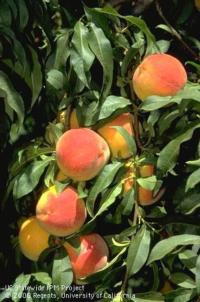Peaches, growing
-
When to plant

Bare-root and transplants
Plant bare-root trees and transplants during winter or early spring while the tree is dormant.How to plant
Fruit trees require full sun to produce good crops.Bare-root
Do not let the tree dry out before planting. Protect the roots - keep roots covered in wet peat moss or similar material - keep the tree in a cool shady place until ready to plant. When ready to plant, remove the packing from the root system, remove broken or decayed roots and then soak the roots in cool water for about 6 to 12 hours.Plant the tree in well-draining soil, either in a raised bed or on a mound to prevent water from pooling at the roots. Soggy soil conditions lead to root diseases.
The hole should be about 1.5 to 2 feet wide and about 1.5 feet deep. Place the tree in the hole, being careful to gently spread out the roots. Refill the hole with native soil; avoid amendments and fertilizers. Be sure the graft union is about 2 inches above the soil line. Water thoroughly.
Transplants
Plant in winter or early spring in well-draining soil. Plant in native soil and water in well; fertilizers are generally not needed the first year.
Read more about planting peach trees.Water
Peach trees need regular irrigation during the growing season to ensure the soil is consistently and evenly moist. This is important for young trees, especially during the first year when the root system is developing. Young trees may need up to 3 to 5 gallons of water per week. Avoid frequent light watering with sprinklers as this creates a shallow root system. A garden hose, soaker hose, or drip system can provide good deep watering. Sandy soils may have to be watered every 3 to 5 days; heavier soils may need to be watered every 1.5 to 2 weeks. During hot weather, young trees may need to be watered more often. Avoid soggy soil.
Do not water established trees near the trunk and lower branches, as this promotes root and crown disease. Water trees around the drip line and beyond. Avoid overhead sprinklers. Water deeply and infrequently (every 2 to 3 weeks) by irrigating for 12 to 24 hours to wet to a 3- to 6-foot depth. If using a drip system, water more on a continual basis.Reduce water in late summer and fall as the tree approaches dormancy.
Read more about watering peach trees.Fertilizer
Use a balanced fertilizer in the spring, and fall, but reduce the amount of nitrogen once fruit begins to form and during fruit maturation.When to expect fruit
Peach trees will begin to bear large crops when they are about 3-4 years old. Peak production is between 8-12 years.
Fruit drop
Peaches always set too much fruit, and a significant number of fruit will drop in June. This is normal.Thinning
Even after the June drop there are generally many fruit still on the tree, and they need to be thinned by hand or the fruit will be small, and there is a risk that the branches will break if there is too much fruit. After the fruit sets on the tree, it will grow to about 1 inch in diameter and then go into a resting stage. Thin the fruit during this resting period. Hand pick fruit on each branch, leaving about 6 to 8 inches between each fruit, taking damaged fruit first. Then remove fruit at the end of branches that may be weakened by heavy fruit.
Read more about thinning.Growing in containers
Dwarf peach trees are available that can be grown in a large container or small garden space. Use good quality, well draining potting soil. The tree will need a sunny location, preferably a minimum of 6 hours of sun per day. Water so that the soil is evenly moist but never soggy. Fertilize more frequently than trees grown in the ground, but avoid nitrogen-rich fertilizer during the summer months. Thin fruit by hand in the same manner as for an in-ground tree.Varieties
Peach trees are short-lived trees (15-20 years), and are self-fruitful, which means that they do not require a second variety to ensure pollinization.Low chill varieties (about 600 chilling hours) adapted for southern California include August Pride, Babcock, Bonita, Desertgold, Early Amber, Earligrande, FlordaGrand, FlordaPrince, Midpride, Tropicberta, TopicSweet
Read more about peach varieties.
Read more about growing peaches in California.

